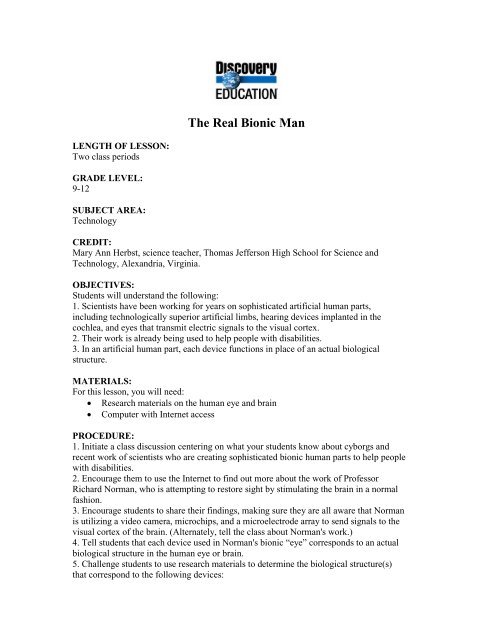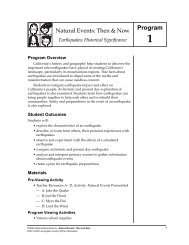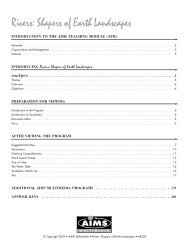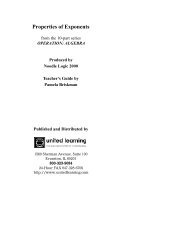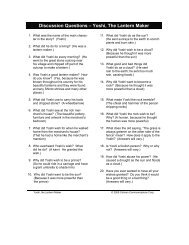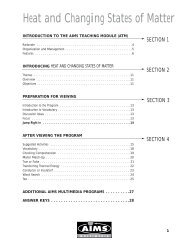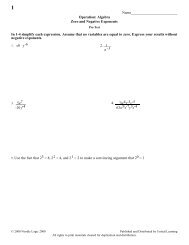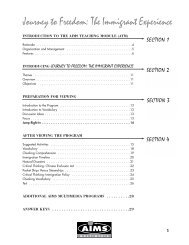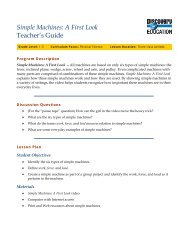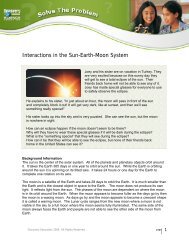The Real Bionic Man - Discovery Education
The Real Bionic Man - Discovery Education
The Real Bionic Man - Discovery Education
You also want an ePaper? Increase the reach of your titles
YUMPU automatically turns print PDFs into web optimized ePapers that Google loves.
LENGTH OF LESSON:<br />
Two class periods<br />
GRADE LEVEL:<br />
9-12<br />
SUBJECT AREA:<br />
Technology<br />
<strong>The</strong> <strong>Real</strong> <strong>Bionic</strong> <strong>Man</strong><br />
CREDIT:<br />
Mary Ann Herbst, science teacher, Thomas Jefferson High School for Science and<br />
Technology, Alexandria, Virginia.<br />
OBJECTIVES:<br />
Students will understand the following:<br />
1. Scientists have been working for years on sophisticated artificial human parts,<br />
including technologically superior artificial limbs, hearing devices implanted in the<br />
cochlea, and eyes that transmit electric signals to the visual cortex.<br />
2. <strong>The</strong>ir work is already being used to help people with disabilities.<br />
3. In an artificial human part, each device functions in place of an actual biological<br />
structure.<br />
MATERIALS:<br />
For this lesson, you will need:<br />
� Research materials on the human eye and brain<br />
� Computer with Internet access<br />
PROCEDURE:<br />
1. Initiate a class discussion centering on what your students know about cyborgs and<br />
recent work of scientists who are creating sophisticated bionic human parts to help people<br />
with disabilities.<br />
2. Encourage them to use the Internet to find out more about the work of Professor<br />
Richard Norman, who is attempting to restore sight by stimulating the brain in a normal<br />
fashion.<br />
3. Encourage students to share their findings, making sure they are all aware that Norman<br />
is utilizing a video camera, microchips, and a microelectrode array to send signals to the<br />
visual cortex of the brain. (Alternately, tell the class about Norman's work.)<br />
4. Tell students that each device used in Norman's bionic “eye” corresponds to an actual<br />
biological structure in the human eye or brain.<br />
5. Challenge students to use research materials to determine the biological structure(s)<br />
that correspond to the following devices:
- Video camera<br />
- Microchips<br />
- Microelectrode array<br />
6. Students should draw a clearly labeled diagram of each device and another diagram of<br />
the biological structure to which the device corresponds. Each pair of diagrams (device<br />
and corresponding biological structure) should be accompanied by a short explanation of<br />
the function of the device and structure.<br />
ADAPTATIONS:<br />
Provide students with a labeled diagram of the human eye, optic nerve, and brain. Hold a<br />
class discussion in which students match up parts of the human eye and brain to the three<br />
devices used in Professor Norman's bionic “eye.”<br />
DISCUSSION QUESTIONS:<br />
1. What technological advances must occur before bionic implants can become a reality?<br />
2. Materials technology is very much a part of the development of bionic parts. What<br />
space-age materials are depicted in the video?<br />
3. <strong>Bionic</strong> enhancement will give rise to many ethical issues, such as the factors used in<br />
determining who receives the implants. What other issues might arise?<br />
4. Which mechanism of enhancement is preferable--electromechanical (e.g., bionic eyes,<br />
prosthesis) or biological (e.g., genetically engineered replacement tissue)? Why?<br />
5. Why is implantation of bionic components so important?<br />
6. Development of bionic humans might require redefinition of the term handicapped.<br />
Would a separate category of enhanced individuals be appropriate?<br />
EVALUATION:<br />
You can evaluate your students on their diagrams and explanations using the following<br />
three-point rubric:<br />
Three points:artificial devices and biological structures correctly paired; all six diagrams<br />
provided; all diagrams accurate and clearly labeled; explanations of functions correct and<br />
clearly stated<br />
Two points:artificial devices and biological structures correctly paired; all six diagrams<br />
provided; most diagrams accurate and clearly labeled; explanations of functions correct,<br />
but lacking in clarity<br />
One point:artificial devices and biological structures incorrectly paired; some diagrams<br />
missing; some diagrams inaccurate, not labeled correctly, or not labeled at all; some<br />
explanations inaccurate<br />
You can ask your students to contribute to the assessment rubric by determining how<br />
devices and structures should be paired<br />
EXTENSION:<br />
<strong>The</strong> <strong>Bionic</strong> Time Line<br />
Invite students to use the Internet to build a time line of technological and medical
advancements in the field of bionics over the last century. Suggest a timescale that will<br />
allow students to see the rapid rate of increase in advancements. Students should choose a<br />
starting point that is relevant to them—perhaps the decade in which their parents were<br />
born. After the time line is completed, have students predict when the first bionic eye,<br />
bionic ear, and so on will be implanted.<br />
Measuring Sensory Input<br />
<strong>The</strong> greatest difficulty in developing artificial hands and arms has been a lack of sensory<br />
input. Have students conduct an experiment that will illustrate this problem. For example:<br />
Design an activity that requires manipulation of small objects, such as tracing a toothpick<br />
or tying a shoelace. Have students perform the activity normally. <strong>The</strong>n have them apply<br />
to the ends of their fingers lotion for relief of sunburns or fever blisters, which will cause<br />
a numbing effect. <strong>The</strong>n they can repeat the experiment and compare results.<br />
Build Your Own Six-Million-Dollar <strong>Man</strong> (or Woman)<br />
Divide the class into groups, and have each group choose a specific organ or system in<br />
the human body to research. Groups should use the Internet to research all the functions<br />
of the chosen organ or system. Next, group members should work together to design a<br />
bionic replacement that will perform equally well. Each design must include a statement<br />
of warranty on parts and labor, and predict what level of maintenance the bionic part<br />
would require. Have students determine prices for their designs. <strong>The</strong>n the class as a<br />
whole can estimate the cost for a fully assembled bionic person.<br />
SUGGESTED READINGS:<br />
"Inventing the Future"<br />
Dana Hawkins, U.S. News and World Report, March 20, 1995<br />
U.S. News describes the exciting biomedical engineering research being conducted<br />
across American campuses, and offers its survey-based ranking of the top 50 graduate<br />
schools in this field.<br />
WEB LINKS:<br />
<strong>The</strong>Whitaker Foundation: Biomedical Engineering News<br />
Read descriptions of the latest-breaking biomedical research being performed, including<br />
the use of polymers in heart surgery and administering insulin shots without needles.<br />
http://www.whitaker.org/news/news.html<br />
Neural Prosthetic Devices<br />
Discusses the use of a bionic electrode being used to restore bodily functions lost through<br />
injury or disease.<br />
http://www.socalbio.org/newsletter/fall96/opel.htm<br />
AIPO - <strong>Bionic</strong> Ear Patent<br />
This is the patent of the Cochlear bionic ear implant. <strong>The</strong> site describes the device and<br />
gives a graphic image of the design.<br />
http://www.aipo.gov.au/fun/patents/02/fun_ear.htm
<strong>Bionic</strong> Valve Project<br />
Shows with photos and drawings how a robot is used in surgery to help locate a tumor<br />
and to prevent damage to arteries.<br />
http://ic-www.arc.nasa.gov/ic/projects/neuro/brain/bio_valve.html<br />
<strong>Bionic</strong> Technologies, Inc.<br />
This is the home page of a company that specializes in developing bionic technologies.<br />
<strong>The</strong> site gives reports on current advances in bionic research.<br />
http://www.bionictech.com/<br />
Cyborgs<br />
Describes a cyborg, offers links for identifying the different types of body replacement<br />
parts.<br />
http://www.tip.net.au/~davidjw/libdata/clonfram.htm<br />
Online Movements from Integrated Orbital Implants<br />
<strong>The</strong> most up-to-date and comprehensive resource for information about developments in<br />
ocular implants and artificial eyes.<br />
http://www.ioi.com/comments.html<br />
VOCABULARY:<br />
cyborg<br />
A composite being in which living and artificial components are combined.<br />
Context:<br />
By definition he is a cyborg--a man-machine hybrid.<br />
microchip<br />
An electronic circuit that consists of components of very small size.<br />
Context:<br />
<strong>The</strong>ir plan is to link a video camera to a microchip embedded in the visual cortex.<br />
laser<br />
Light Amplification by Stimulated Emission of Radiation. A device that converts incident<br />
electromagnetic radiation of mixed frequencies to discrete frequencies of highly<br />
amplified and coherent visible radiation.<br />
Context:<br />
<strong>The</strong>y also intend to use a pair of camera glasses, but this time the TV signal will not go<br />
directly to the brain but will be sent by a laser into the eye.<br />
carbon fiber<br />
A technologically advanced material which has the properties of high strength and light<br />
weight.<br />
Context:<br />
It's made of carbon fiber, weighs only four-and-a-half pounds, has 10 speeds and a shock<br />
absorber.
prosthesis<br />
An artificial replacement for a missing body part.<br />
Context:<br />
It's the most important part of the whole prosthesis.<br />
actuators<br />
Devices that put an object into motion.<br />
Context:<br />
<strong>The</strong>re isn't space for all of the man-made actuators that we would like to install to move<br />
every joint of an artificial limb.<br />
ACADEMIC STANDARDS:<br />
Grade Level:<br />
9-12<br />
Subject Area:<br />
physical science<br />
Standard:<br />
Understands energy types, sources, and conversions, and their relationship to heat and<br />
temperature.<br />
Benchmarks:<br />
Knows that the energy of waves (electromagnetic and material) can be changed into other<br />
forms of energy (e.g., chemical and electrical), just as other forms of energy (chemical<br />
and nuclear) can be transformed into wave energy.<br />
Grade Level:<br />
9-12<br />
Subject Area:<br />
physical science<br />
Standard:<br />
Understands motion and the principles that explain it.<br />
Benchmarks:<br />
Knows that waves (e.g. sound, seismic, light, water) carry energy and can interact with<br />
matter.<br />
Grade Level:<br />
9-12<br />
Subject Area:<br />
technology
Standard:<br />
Understands the nature of scientific knowledge.<br />
Benchmarks:<br />
Knows that because all scientific ideas depend on experimental and observational<br />
confirmation, all scientific knowledge is, in principle, subject to change as new evidence<br />
becomes available; in areas where data, information, or understanding is incomplete, it is<br />
normal for scientific ideas to be incomplete, but this is also where the opportunity for<br />
making advances may be greatest.<br />
Grade Level:<br />
9-12<br />
Subject Area:<br />
technology<br />
Standard:<br />
Understands the nature of technological design.<br />
Benchmarks:<br />
Proposes designs and chooses between alternatives (e.g.; models, simulations).<br />
Grade Level:<br />
9-12<br />
Subject Area:<br />
technology<br />
Standard:<br />
Understands the interactions of science, technology, and society.<br />
Benchmarks:<br />
Knows that science often advances with the introduction of new technologies and solving<br />
technological problems often results in new scientific knowledge; new technologies often<br />
extend the current levels of scientific understanding and introduce new arenas of<br />
research.<br />
Grade Level:<br />
9-12<br />
Subject Area:<br />
technology<br />
Standard:<br />
Understands the interactions of science, technology, and society.<br />
Benchmarks:<br />
Knows that science and technology are pursued for different purposes; scientific inquiry<br />
is driven by the desire to understand the natural world and seeks to answer questions that
may or may not directly influence humans; technological design is driven by the need to<br />
meet human needs and solve human problems and has a more direct effect on society<br />
than science because its purpose is to solve human problems; help humans adapt, and<br />
fulfill human aspirations.<br />
Copyright 2001 <strong>Discovery</strong>.com.<br />
Teachers may reproduce copies of these materials for classroom use only


